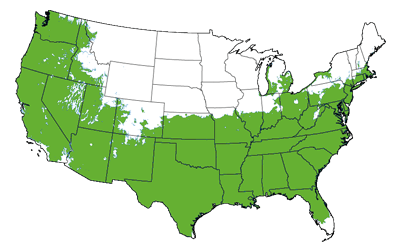Cityline Berlin Bigleaf Hydrangea
Product Details
 Growing Zones 6-9
Growing Zones 6-9
| Soil Type | Well Drained |
| Sunlight | Full, Partial |
| Drought Tolerance | Semi |
| Mature Height | 3-4 Feet |
| Mature Width | 4-5 Feet |
| Growth Rate | slow |
| Fall Color | Green |
| Bloom Color | Blue, Multicolored, Pink, Purple |
| Brand | Proven Winners® |
| Shipping Restriction | AZ |
The Cityline® Berlin Bigleaf Hydrangea is a hybrid from Germany that is a new and improved Hydrangea! No more drooping blooms with this new dwarf series. It is a maintenance free shrub that requires no pruning and is mildew resistant. Beautiful clustered blossoms are produced during the summer with intensely pigmented colors that eventually turn green with age.
Features: The Cityline® Berlin Bigleaf Hydrangea is a compact shrub that contains intensely pigmented blooms on top of long sturdy stems. The small and compact nature of these shrubs allows it to fit in tight spaces. The colors of the tight flower heads depend upon the pH level of the soil. Acidic soil produce blue flowers, while alkaline soil produces pink flowers. As the flowers age, the petals eventually turn green.
How to care for your Hydrangea: Plant this Hydrangea in well drained soil and an area with partial shade. If planted in full sun, this plant will need a maintained watering schedule. Pruning is not necessary, but can be pruning immediately after flowering occurs. Prune out dead or winter damaged stems in the late winter to early spring.
PH levels within the soil affect the bloom color of flowers. Acidic soils are grow blue flowers whereas alkaline soils produce pink flowers. Add aluminum sulfate to produce acidic soil, and lime to create alkaline soil. Begin these treatments either in fall or early spring.
When planting your Cityline Berlin Bigleaf Hydrangea be sure you have the right location and conditions for your new plants to thrive. Spring and Fall are ideal times to plant Hydrangeas. Avoid planting hydrangeas in summer when temperatures are mid80s or higher.
The Cityline Berlin Bigleaf Hydrangea requires full sun to part shade and prefers moist, well-drained, fertile soil. In hot climates, hydrangeas will do best with some shade. If you have alkaline soil and want a blue hydrangea, be sure to amend your soil. To acidify your soil, amend with aluminum sulfate or elemental sulfur. If you are seeking a pink color, add lime several times per year. Keep the soil moist, but not saturated, especially in summer and in the first year after planting. Throughout its life Hydrangeas will do best with a deep watering once weekly during hot temperatures. Mulching at about 3 inches deep is highly recommended for hydrangeas. Mulching will cut back on watering needs and protect your plant in extreme temperatures. Choose a slow release fertilizer for flowering plants. Fertilize once in spring after the last chance of frost and again in early summer for best results. You don’t need to prune hydrangeas, but pruning after they are done blooming can help encourage a bushier growth and renew an older plant.
The best way to prevent disease and pests is by providing the appropriate care for your plants. Proper location choice, watering, and fertilization are the keys to your success. You can treat mites, scale, whiteflies, and aphids naturally with neem oil or insecticidal soap. For severe infections you can use pesticides like carbaryl, also known as Sevin. Fungal infection can be prevented by making sure the planting site has good drainage and by avoiding overhead watering. Fungal infections can be treated with a fungicide. Generally, treating fungus after infection isn't effective so if you have problems with other plants or in a prior year, treat preventatively in early spring.










